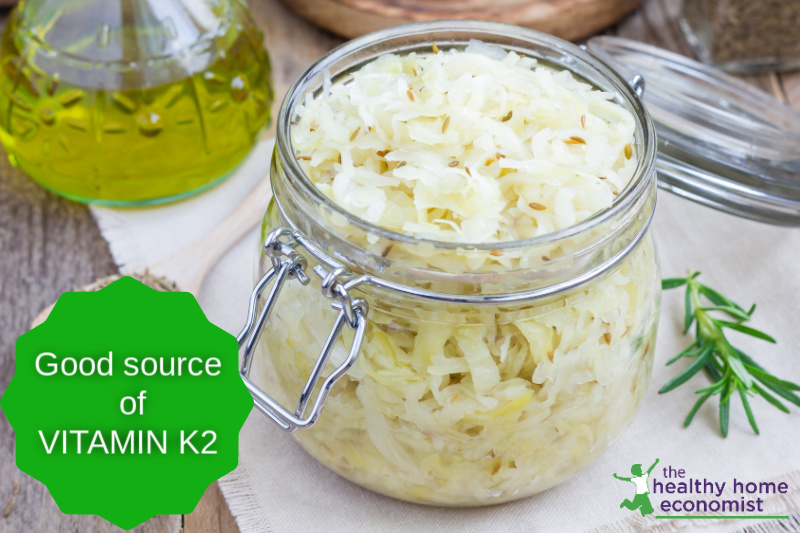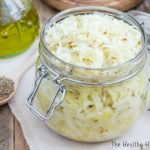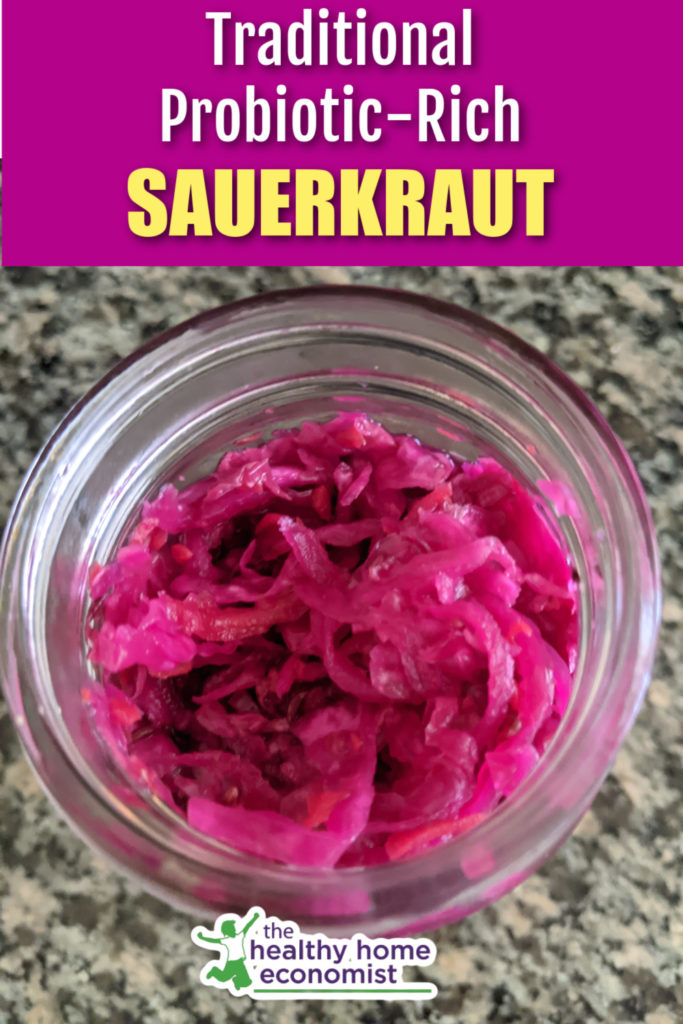Recipe and detailed video instruction on how to make traditional sauerkraut that is loaded with probiotics and Vitamin K2 for better digestion and health. 
By popular demand, the process of making homemade sauerkraut is explained and demonstrated in the two video lessons below. The written recipe is also provided by those who wish to dive right in.
This traditional food is probiotic-rich and very nutrient-dense unlike the vinegar-packed sauerkraut wanna-be’s at the store.
The first video covers a brief history of sauerkraut and what you need on hand to make it. The second video covers how to make sauerkraut yourself quickly and easily in your kitchen.
The sauerkraut recipe I use is based on the Nourishing Traditions method.
Benefits of Fermenting Cabbage
Eat small amounts of this probiotic-rich condiment with cooked foods to improve digestion and assimilation.
Remember that fermenting does not reduce the goitrogens (thyroid suppressing substances) in the cabbage. So, if you have thyroid issues, you may wish to consider avoiding this particular condiment.
If your thyroid status is good and you eat plenty of iodine-rich foods like grassfed butter, then sauerkraut is a healthy addition to the diet.
Loaded with Vitamin K2
Did you know that properly cultured cabbage contains a significant amount of natural Vitamin K2? This is an elusive nutrient that is very hard to get in the diet. It is essential for strong bones and healthy teeth.
The USDA reports that one cup of sauerkraut contains 81 mcg. No doubt this is the commercial, pasteurized stuff that the USDA is testing too.
I would venture to suggest that making raw sauerkraut yourself and fermenting properly would potentially contain larger amounts.
Natural Remedy for Reflux
Another bonus of eating raw fermented cabbage is that it is a natural way to prevent acid reflux. Simply eat a mouthful or two a few minutes before the start of a meal.
Want to experience these benefits for yourself? Two detailed video lessons are included with the recipe below.
Tip: Be sure to wear an apron when you make this dish as you will see in the video! ?
Why don’t you try it today! You will never go back to the pasteurized, shelf stable sauerkraut at the store!

Homemade Sauerkraut Recipe
Basic recipe for homemade sauerkraut as traditionally made as a live cultured food loaded with probiotics and enzymes to aid digestion and absorption of nutrients.
Ingredients
- 1 green or purple cabbage medium size, preferably organic
- 4 Tbl liquid whey
- 1 Tbl caraway seeds
- 1 Tbl sea salt
Instructions
-
Core and chop cabbage. Place all the chopped cabbage and other ingredients together in a large sturdy bowl.
-
Pound the juices out of the cabbage thoroughly with a kitchen pounder of some kind for a full 10 minutes.
-
Tightly pack the cabbage into a one quart mason jar leaving at least 1 inch of space at the top. Tightly seal with the lid.
-
Leave on the counter for 3 days and then refrigerate.
-
The flavor of the homemade sauerkraut improves over time. It will last many months in your refrigerator or cool cellar.
Recipe Video

References
(1) Vitamin K2 in Sauerkraut
(2) Nourishing Traditions
More Fermented Food Recipes
Love this sauerkraut recipe? Try these other delicious fermented foods and drinks below and unleash the power of a traditional diet in your home.
How to Make Fermented Lemonade
How to Make Orangina
Mango Chutney Recipe
Homemade Apricot Butter
Fermented Potatoes
Probiotic Corn Relish
How to Make Fermented Cilantro Salsa
Beet Kvass Recipe








Should be a lighter, yellowish color with some bubbling on top.
What should it look like when it is finished. I live in Canada and it is – 30 C outside, but inside is a warm 21 C, it has been sitting for 2 days so far.
Hi Kelsey, when you refridgerate the sauerkraut, it slows the fermentation way down, so any bubbling/rising liquid will settle down. Yes, the brown is ok, just scrape it off and the rest is fine.
Sarah,
The same thing happened to me. So you’re saying that I just discard the brown sauerkraut at the top of the jar and discard it, and the rest of the sauerkraut is safe to eat? Is the brown sauerkraut dangerous?
So I have another question! While the kraut was fermenting, the liquid rose up to the top of the jar, which I was a little concerned about but it never exploded, so it was ok. But then when I put it into the fridge after fermenting, all the liquid kind of disappeared. Is that ok? Also, one of the jars got a little brown on the top. Do I just scrape that off and eat the rest, or is that normal? Thanks!
I am reading Eat Fat, Lose Fat. It says that you can make Sauerkraut without the whey and double the salt. I noticed you also say this, I was wondering if I make it without the whey will it still have the probiotic benefits? Is it just as healthy?
Also, thank you so much for the FREE cooking videos!! I have learned so much from you and I really appreciate them.
Hi Kelsey, you can make the saurkraut with salt only and no whey if you like. Just double the salt. I've never tried the GAPS method so can't be of any help there.
Hi Sarah! Thanks for the video! Very helpful. I'm about to start the GAPS intro diet and I was just curious because her recipe is quite different from the NT version. She doesn't use any liquid whey or salt (which is strange), and she weighs hers down in the bowl and leaves a slight gap for the fermentation juices to escape, and hers ferments a bit longer than yours. Do you think hers ferments longer because she doesn't use the liquid whey? I'm planning on making my first batch today with cabbage I'm going to get at the farmers market, but was just curious if you or anyone else has tried the GAPS method and how different it is. Thanks!
Sarah, I am hypothyroid and from what I understand am not supposed to eat raw cruciferous veggies (they are goitregens.) I'm hoping that fermented cabbage is okay though – do you know?
Hi Ashley, what you have described is fine. Just be sure to leave at least 1 inch at the top for air.
Hello Sarah, this was my 1st attempt at making sauerkraut and I can't believe how easy it was! Thanks so much for your video, I wouldn't have gotten the confidence to do it, had you not given the visual instruction. I do have a couple of questions to make sure I did it correctly. After pounding mine for 10 mins, it generated a lot more liquid than yours. So, when I put it in the mason jar, I had about an inch and a half of liquid at the top (and it formed little bubbles). Does this mean that it won't work? The liquid also made my cabbage 'float' a little. I fit all of the cabbage in 1 jar though. Any advice is appreciated.
Thanks so much!
Ashley